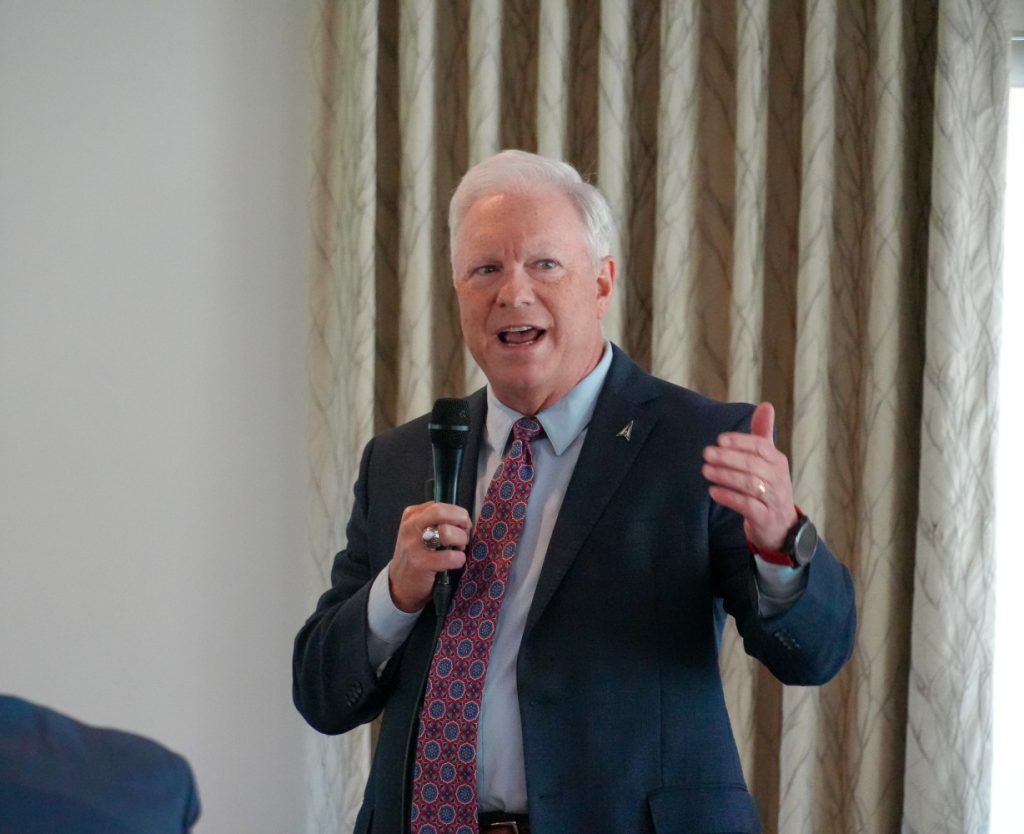At DVIRC’s 2025 Manufacturing Executives Conference, retired Lieutenant General JT Thompson, former Commander of the U.S. Space Force’s Space and Missile Systems Center, delivered a clear message: the space economy isn’t a distant dream. It’s a rapidly growing, high-stakes opportunity, and manufacturers in our region are well-positioned to lead.

Lt. Gen. (Ret.) JT Thompson shares insights on the future of space manufacturing during his keynote at the 2025 Manufacturing Executives Conference.
Why Now: The Strategic Case for Space
From GPS and financial transactions to supply chains and national defense, space-based technologies quietly power much of modern life. But space is no longer uncontested—it’s a domain facing increasing threats, from cyberattacks and jamming to orbital debris and anti-satellite weapons. As General Thompson emphasized, securing our space infrastructure is as much about national resilience as it is about innovation.
At the same time, commercial momentum is exploding. Venture capital is pouring into launch, satellite, and space services—fueling startups and expanding the industrial base far beyond traditional aerospace hubs.

Private investment in commercial space has grown more than 10X over the last decade, reaching nearly $28B in 2024.
The Opportunity: Manufacturing’s Role in a $1 Trillion Economy
The U.S. space economy is already valued at $250 billion and is projected to quadruple by 2040. That growth will depend on scaling advanced manufacturing capacity—from precision machining and composites to integration, electronics, and launch support infrastructure.

The U.S. space economy is projected to surpass $1 trillion globally by 2040, with American manufacturers playing a key role.
For the Delaware Valley—home to shipbuilding, complex systems engineering, and technical labor pipelines—the parallels are striking. Many core capabilities are directly transferable:
- Modular construction → satellite integration
- Corrosion-resistant materials → spacecraft shielding
- Precision machining → propulsion and avionics systems
- Systems integration → launch prep and testing
A Roadmap for Diversification
General Thompson outlined a clear strategy to help regions like the Delaware Valley diversify into the space manufacturing sector while retaining their strengths in legacy industries such as shipbuilding and defense. He emphasized the economic and strategic benefits of growing these sectors in parallel.
The Delaware Valley already brings valuable assets to the table: a strong foundation in heavy manufacturing, skilled technical labor, complex systems integration, and established coastal infrastructure. These capabilities align well with the needs of space-related manufacturing, including satellite structures, launch components, and support systems.
To guide this transition, Thompson proposed a three-phase roadmap:
- Foundations & Capability Expansion – Identify and align transferable skills—such as modular construction and corrosion-resistant materials—from shipbuilding and other industries to space manufacturing applications.
- Pilot Programs & Ecosystem Activation – Launch early-stage projects in partnership with NASA, the Department of Defense, and commercial aerospace firms to build experience, trust, and technical readiness.
- Scaling & Integrated Growth – Expand capacity to produce more complex systems, such as propulsion and avionics components, while strengthening supply chain networks and qualifying regional suppliers to serve the space industry.
He also highlighted the need for proactive economic development strategies to attract outside investment. These include state and local incentives, workforce programs, special zoning, regulatory streamlining, and robust public-private partnerships.
As for companies to target, Thompson pointed to a mix of commercial space manufacturers, defense and aerospace primes, and space-tech startups—all of whom are looking for skilled partners to help scale production.
Talent: The Core of Space Readiness
Perhaps the most urgent call to action is around talent. Space workforce demands mirror those of manufacturing, but with an even greater emphasis on flexibility, certification, and cleanroom readiness. It’s not just about engineers—skilled trades are essential.

Manufacturing represents nearly a quarter of all space-related jobs—and demand is growing fast.
To meet this demand, General Thompson emphasized the need for a comprehensive approach to workforce development. He called for expanding STEM education and building enthusiasm among the next generation, starting in schools and continuing through higher education. University-industry partnerships and internships can help bridge the gap between education and real-world application.
He also stressed the importance of skilled labor. This includes developing new apprenticeship pipelines, expanding cleanroom and precision assembly training, and creating pathways for veterans and aerospace workers to transition mid-career. Many of these roles require specialized certifications, such as security clearances and cleanroom credentials.
Thompson’s message was clear: building a flexible, multi-skilled workforce is essential—not just for economic growth, but for national security and leadership in the space economy.
Let’s Launch
Diversifying into space manufacturing offers a unique opportunity to grow the region’s economy, strengthen national security, and build on existing industrial capabilities. With a strategic approach and support from public and private partners, small and mid-sized manufacturers can play a vital role in this next frontier.
DVIRC is committed to supporting this vision by helping manufacturers in the region assess their capabilities, identify transferable strengths, and connect with the partners and programs needed to succeed in this growing sector. Whether through workforce development, supply chain support, or strategic guidance, DVIRC stands ready to help companies take their first steps into space manufacturing.
To learn more about how DVIRC is supporting manufacturers entering the space industry, contact us.
